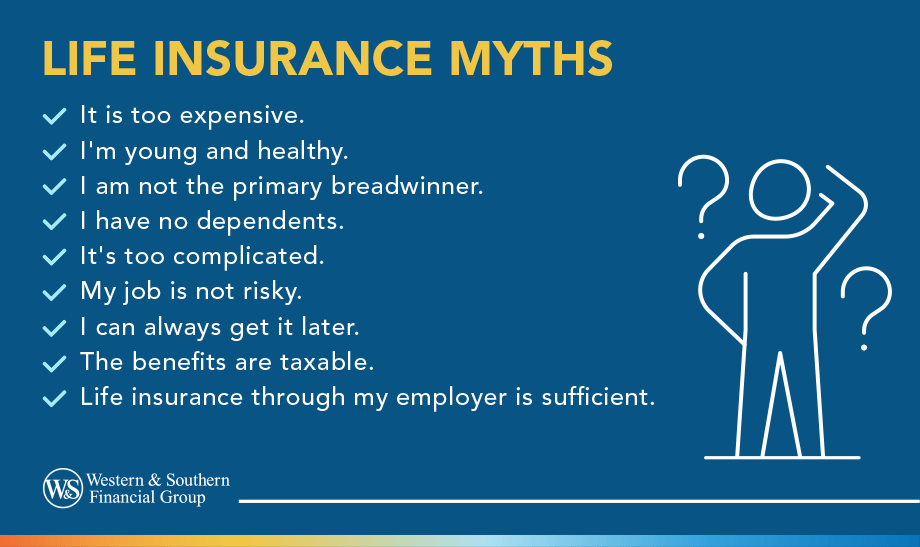

Key Takeaways
- Contrary to popular belief, life insurance can be affordable, especially for young and healthy individuals.
- Life insurance helps benefits young, healthy individuals with lower premiums and long-term financial security.
- Life insurance is essential for all family members, including stay-at-home parents and secondary earners, to help ensure financial stability.
- Supplementing employer-provided life insurance with a personal policy helps ensure comprehensive financial protection.
- With online tools, obtaining life insurance has become more straightforward, and it is essential for anyone with financial obligations or dependents, regardless of job risk.
Life insurance is often surrounded by misconceptions that prevent individuals from making informed decisions about their financial security. Many myths can lead to underestimating the value of life insurance or misjudging its importance in a comprehensive financial plan.
Learn more about the most common myths about life insurance, offering clarity and highlighting the benefits of having an appropriate policy in place.
Myth 1: "Life insurance is too expensive."
Many people think life insurance is too expensive, but it can be affordable. A study by LIMRA found that 72% of Americans overestimate the cost.1 For example, a healthy 30-year-old non-smoker female can get a 20-year, $500,000 term life insurance policy for about $20 to $30 monthly.
Life insurance costs vary based on age, health, and coverage amount. Many people can find a plan that fits their budget by comparing different policies and providers. It's important to consider life insurance as a vital part of financial planning rather than an unnecessary expense. By doing so, you can ensure that your loved ones are financially protected without breaking the bank.
Myth 2: "I don't need life insurance because I'm young and healthy."
Life insurance isn't just for older adults or those with health issues. Even if you're young and healthy, getting life insurance now locks in lower premiums for the future, as rates are based on age and health status.
Millennials Regret
Life insurance isn't just for end-of-life expenses; it's also a safety net for unexpected events. Accidents and sudden illnesses can happen to anyone, no matter their age. Having a policy helps ensure that your loved ones won't face financial difficulties, such as unpaid debts or funeral costs if you pass away unexpectedly. Considering these factors early on can provide long-term benefits and economic security for both you and your family.
Myth 3: "Only the primary breadwinner needs life insurance."
Remember that life insurance isn't just for the primary breadwinner. Stay-at-home parents and secondary earners also make valuable contributions to the family. Replacing their services could be substantial if something were to happen to them. In 2024, the median annual salary for a stay-at-home parent’s work is estimated between $41,245 to $57,921.3
Similarly, secondary earners contribute significantly to the family’s financial health through income or additional support that allows the primary earner to work more hours. Life insurance for all contributing household members helps safeguard the family's economic stability, covering potential gaps that might arise from losing any family member's contributions.
Myth 4: "Life insurance through my employer is sufficient."
Many people believe their employer's life insurance is enough to cover their needs, but this might only sometimes be true. Employer-sponsored life insurance policies often offer additional coverage of one or two times your annual salary. While this might sound like a significant amount, it usually needs to catch up when considering long-term financial obligations such as mortgage payments, children's education, and daily living expenses for your family.
Additionally, employer-provided life insurance is typically tied to your job. If you leave your job or are laid off, you could lose your coverage, leaving you and your family unprotected. Therefore, supplementing employer-provided life insurance with a personal policy is often wise to help ensure comprehensive coverage.
Myth 5: "Life insurance is only for people with dependents."
Life insurance is often thought to be only for people with dependents, but that's not true. It can be helpful for anyone, no matter their family situation. For example, if you have significant debts like a mortgage or student loans, life insurance can help ensure they get paid off and don't burden your family or co-signers. It can also cover end-of-life costs, like funerals, burials and cremations.
Average Funeral Costs
Additionally, some policies build up cash value over time, which you can borrow against or withdraw money from, giving you financial flexibility. If you're young and healthy, you can get lower premium rates, which makes life insurance an intelligent way to help secure your financial future. So, life insurance does more than help protect dependents—it's a flexible part of an excellent financial plan.
Lock in lower premiums now and avoid future regrets. Get a Free Life Insurance Quote
Myth 6: "It's too complicated to get life insurance."
Getting life insurance is easier than you might think. The process is now more straightforward with online platforms and better customer service. Many life insurance companies provide online quotes, simple application processes, and quick customer support.
Finding the best life insurance company for your needs is also important. First, you can research different companies and compare their offerings to find the right policy. Life insurance agents can help you understand different types of life insurance and find a policy that suits your needs and budget.
By using these resources, you can simplify the process and make informed decisions without feeling overwhelmed.
Myth 7: "Life insurance is only necessary if you have a risky job."
Life insurance is essential for everyone with dependents or financial obligations, not just those in risky jobs. It's a crucial financial tool that provides your loved ones with a safety net. Whether you're a teacher, an office worker, or a single parent, life insurance helps ensure your family can maintain their standard of living if something happens to you.
Life insurance replaces lost income. It covers expenses like mortgages, education, and living costs, making it relevant for all workers, not just those with risky jobs. Additionally, Forbes reported that 28% of American households would face financial hardship within a month if a primary wage earner died.4 Therefore, life insurance is essential for anyone wanting to help protect their family's economic future.
Myth 8: "I can always get life insurance later."
Many believe they can only buy life insurance once they're older or their health changes, but this misconception can be costly. As you age, life insurance premiums typically increase because the risk to the insurer grows. Additionally, unexpected health issues can arise anytime, potentially making qualifying for affordable coverage later tricky or even impossible.
Life Insurance Misconceptions
This delay can result in higher premiums or coverage denial. To help ensure protection at a reasonable cost, it's best to secure life insurance when you're younger and healthier.
Myth 9: "Life insurance benefits are taxable."
Life insurance benefits are generally not taxed. When someone with a life insurance policy dies, those who get the money don't usually have to pay income tax. The Internal Revenue Service (IRS) says that life insurance money paid to someone after the policyholder dies is not part of their income, so it's not taxed.
Life insurance money is generally tax-free, but there are some exceptions. If the money is paid out in installments, the interest on those payments might be taxed. Also, if the policyholder's estate is large enough to be subject to estate taxes, the life insurance money might be included and taxed. Life insurance can be an excellent way to help ensure your loved ones are cared for without worrying about extra taxes.
Conclusion
Debunking life insurance myths is crucial for understanding its actual value in financial planning. Life insurance offers more than just end-of-life expenses; it helps provides a safety net for unexpected events and long-term financial security for loved ones. By recognizing the affordability and necessity of life insurance, individuals can make informed choices that help ensure their family's economic well-being.
Don't let myths hold you back—add a life insurance policy for complete coverage. Get a Free Life Insurance Quote
Sources
- U.S. Life Insurance Need Gap Grows in 2024. https://www.limra.com/en/newsroom/news-releases/2024/u.s.-life-insurance-need-gap-grows-in-2024/.
- Why Millennials Buying Life Insurance? https://medium.com/forinsurer/why-millennials-buying-life-insurance-adf96d84b7ed.
- Stay At Home Mom Salary. https://www.salary.com/research/salary/recruiting/stay-at-home-mom-salary.
- Life Insurance Statistics, Data And Industry Trends 2024. https://www.forbes.com/advisor/life-insurance/life-insurance-statistics/.

















































